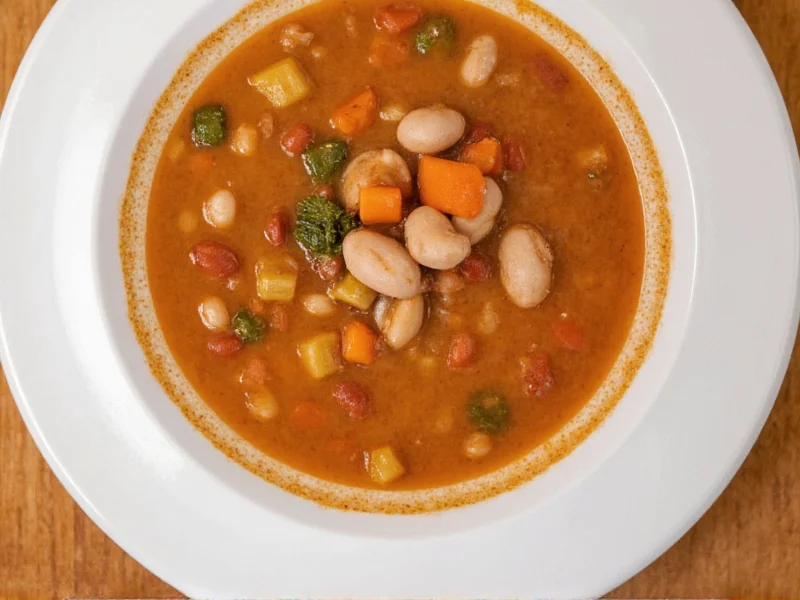Navy bean soup represents one of America's most enduring comfort foods, with roots tracing back to early New England kitchens. These small, oval-shaped white beans, formally known as Phaseolus vulgaris, earned their "navy" designation when adopted by the United States Navy in the 19th century for their exceptional shelf life and nutritional value during long voyages. Today, this humble soup continues to grace tables across the country, appreciated by home cooks for its straightforward preparation and remarkable adaptability.
The Nutritional Powerhouse in Your Pot
Navy beans form the foundation of this nutritional powerhouse. A single cup of cooked navy beans delivers approximately 15 grams of protein and 19 grams of dietary fiber, making navy bean soup an exceptional choice for maintaining digestive health and managing blood sugar levels. The soup's complete nutritional profile includes significant amounts of iron, magnesium, potassium, and B vitamins. Unlike many comfort foods, a standard serving of navy bean soup contains only about 200 calories while providing sustained energy release due to its complex carbohydrate structure.
Understanding Navy Beans: More Than Just a Small White Bean
Many people confuse navy beans with other small white beans, but they possess distinct characteristics. Navy beans are smaller and more delicate than great northern beans, with a thinner skin that breaks down more easily during cooking. This quality creates the signature creamy texture that defines authentic navy bean soup. When shopping for ingredients, look for beans that are uniform in size and color with no cracks or blemishes. Dried beans typically offer better flavor and texture than canned alternatives for traditional navy bean soup preparation.
| Bean Type | Size Comparison | Cooking Characteristics | Best For |
|---|---|---|---|
| Navy Beans | Smallest (1/4 inch) | Delicate skin, breaks down easily | Creamy soups, baked beans |
| Great Northern | Larger (3/8 inch) | Holds shape better | Salads, stews |
| Cannellini | Largest (1/2 inch) | Firm texture | Italian dishes, purees |
Mastering the Traditional Navy Bean Soup Recipe
Creating an exceptional navy bean soup requires attention to technique rather than complexity of ingredients. The traditional preparation begins with soaking dried navy beans overnight, though modern methods offer quicker alternatives. For authentic flavor development, start by sautéing onions, carrots, and celery—the classic mirepoix—in olive oil or bacon fat until softened but not browned. Add the soaked beans along with aromatics like bay leaves and thyme, then cover with fresh water or broth. The critical element in traditional navy bean soup preparation involves maintaining a gentle simmer rather than a rolling boil, which can cause the beans to break apart prematurely.
Many traditional recipes incorporate a ham hock or smoked turkey leg to provide depth of flavor without overwhelming the delicate bean taste. These should be added at the beginning of cooking to allow maximum flavor extraction. The soup typically requires 1.5 to 2 hours of simmering until the beans reach perfect tenderness. For the creamiest texture, blend about one-third of the finished soup before serving, which thickens the broth naturally without adding flour or cream.
Variations Across Kitchens and Diets
The beauty of navy bean soup lies in its adaptability to various dietary needs and flavor preferences. For vegetarians, replace meat-based flavorings with kombu seaweed or smoked paprika to achieve similar depth. Mediterranean variations often include tomatoes, oregano, and a splash of red wine vinegar. In colder months, adding root vegetables like parsnips or turnips enhances the soup's heartiness. Modern adaptations might incorporate instant pot preparation, reducing cooking time while maintaining flavor integrity.
When adapting navy bean soup for special diets, consider these adjustments:
- For gluten-free diets: Ensure broth is certified gluten-free
- For low-sodium diets: Use homemade broth and limit added salt
- For vegan preparation: Substitute vegetable broth and omit meat products
- For enhanced protein: Add a tablespoon of nutritional yeast per serving
Serving Wisdom and Storage Techniques
Navy bean soup reaches its flavor peak when allowed to rest overnight, making it an excellent make-ahead dish. Serve with crusty bread for dipping or a simple green salad for a complete meal. The soup freezes exceptionally well for up to three months when stored in airtight containers with at least one inch of headspace for expansion. When reheating navy bean soup, add a small amount of water or broth as the beans will continue absorbing liquid during storage. For restaurant-quality presentation, garnish with fresh herbs like parsley or chives just before serving.
Troubleshooting Common Navy Bean Soup Challenges
Even experienced cooks occasionally encounter issues with navy bean soup preparation. If your beans remain hard after extended cooking, check their age—older beans require longer cooking times. Hard water can also prevent proper softening; try adding a pinch of baking soda to the cooking water. For soups that become too thick during storage, gradually incorporate additional broth while reheating. If the flavor seems flat, balance with acid—try a splash of apple cider vinegar or lemon juice to brighten the taste profile. Remember that navy beans naturally release starch as they cook, which thickens the broth, so resist the urge to add thickeners unless absolutely necessary.











 浙公网安备
33010002000092号
浙公网安备
33010002000092号 浙B2-20120091-4
浙B2-20120091-4